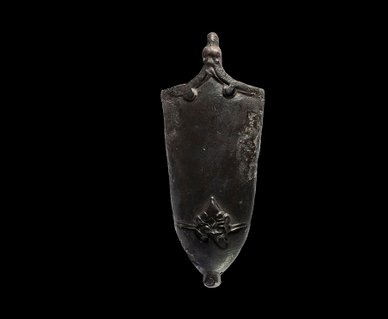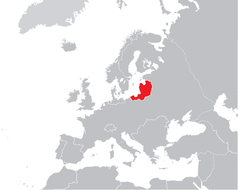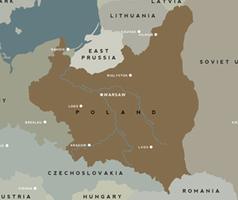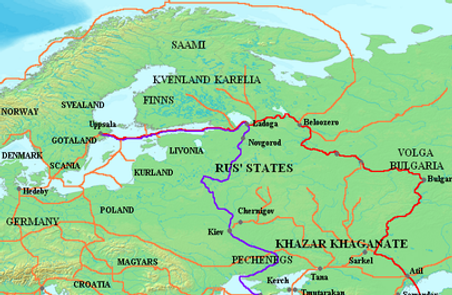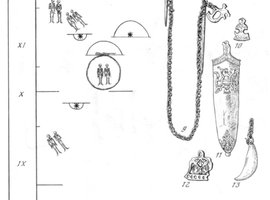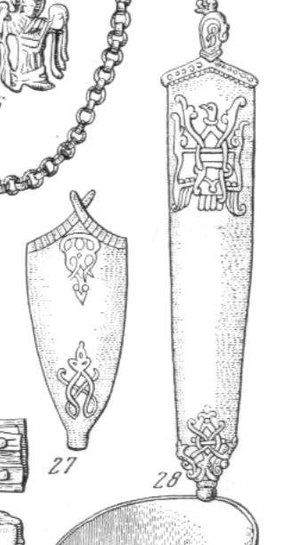Viking-Age sword chape with oriental palm motif
This week I like to show you a special kind of Viking-Age sword chape. These kind of sword chapes can be devided in three specific groups, all being characterized by their 'closed casting', their distinct execution with oriental (palm) motif and their sometimes remarkable size (lenght).
On these chapes the typical Scandinavian animal ornament had been replaced by a oriental palm (motif), although the Nordic nature of the form is there, the openwork charachter (as can be seen p.e. on the sword chape with falcon motif, discussed in the article of January 13th had been replaced by a closed casting.
The three catagories of groups of these kind of sword chapes wich can be defined are:
- a Varangian group;
- a Varangian-Baltic group and
- a Baltic-East Prussian group.
I'm not quite sure if the sword chape here discussed is of Varangian-Baltic origin, or of Baltic East-Prussian origin.
It's lenght - 12 centimeters - (4 3/4") finds a parallel in a sword chape of Varangian-Baltic type, being found in Beszterec in Hungary, although it is less ornamented especially on top of the chape. As not is known where this sword chape was found, we have to concentrate on the specific area to wich this sword chape had been addressed to: East-Prussian.
Of course, 'Baltic' and 'Baltic-East Prussian' are modern addressed names to define an area geographically where these kind of chapes were found.
The Varangians term however is a true ancient describtion given by the Greeks and the East-Slavs to vikings who between the 9th and 11th centuries ruled the medieval state of Rus' and formed the Byzantine Varangian Guard.
Here we get to the centre of the explanation why a oriental motif like the palm is appearing on these kind of chapes. The original production and origin of the kind of chapes addressed as 'the Varangian Group' is situated in the area of Kiev, and found their way of origin even further east on the Wolga river.
Whatever the group it belongs to, the sword chapes with this distinct motif had been found in a great area, consisting finding spots as: Madara in Hungary, the area of Kiev in Ukrain, Philippopel in Bulgary, Biljarsk in Russia, Zloczöw in Poland, Latvia, and besides several other area in East-Prussian, Linkuhnen in East-Prussia (toda's northeastern area of Poland). Why it has its wide area the map of the Varangian trading routes shows us.
One of the (marked orange) trading routes leads directly to East-Prussia. Travelling all their way to the deep south of Russia and to Constantinople, the Varangians must have either copied an already excisting motif or find their inspiration on the oriental motif of a palm, in use in the southern areas wich whom they travelled. With a addictive intrest in everything from far beyond the known (as can be seen by the trading in beads coming from the far south and Byzanthium) it is no wonder these motifs found their way north.
Nevertheless, these kind of sword chapes - as to my current knowlegde - haven't been found in Scandinavia itself.
The 'magnus opus' of both size and ornament on these specific kind of sword chapes can be found in the group being found in Treyden in Latvia. Being 22.6 (!) cm. length and 4,6 cm width with outstanding ornament execution, this sword chape is one of the finest known from the Viking-Age. Several images can be seen in the book wich I refer to.
The drawings of other sword chapes with oriental palm motif are from a Russian book, wich title I still have to discover and will address later on.
Reference:
Paulsen, Peter, Schwertortbänder der Wikingerzeit, 1953: Ortbänder mit orientalischer Palmette, p. 59 - 87.
Note: a lot of references to books and publications are being mentioned within the Peter Paulsen's book itself. As the book is from 1953, these publications go way back, nevertheless are frequently very interesting as they hadn't been republished afterwards and nowadays often only can get aquired antiquarian. (link to online bookstore in Germany:
AntikMakler.
Buchversand für neue, antiquarische und gebrauchte Bücher mit dem Schwerpunktbereichen Archäologie, Geschichte, Antiquitäten und Publikationen.
Not cheap, but worth every penny !
Note: I just ordered an intruiging new book:
Fedir Androshchuk, Viking Swords. Swords and Social aspects of Weaponry in Viking Age Societies, 2014, Te Swedish history Museum, Studies 23ISBN 978-91-89176-51-5
Within this book besides 832 (!) Scandinavian swords wich had been found (never knew it were that amount frankly), also scabbards and scabbard chapes, sword belts and baldrics are being addressed.
On page 113, scabbard chapes, birds of prey and eastern connection are being discussed. If this chapter gives more reference to the kind of sword chape discussed above, I will add this information to this article.
See also:
Viking Swords. Swords and Social aspects of Weaponry in Viking Age Societies (online resumé)
It can be ordered hardcopy here
Link to blog of last week February 10th 2015
Well. I could have been with these stones until after dark, but as my wife wanted to travel on.. well.. I see you again, some day, hogback stones from Gosforth. And if you happen to be there one day, do not forget that monument on the outside...
Further on with the Cumbrian hogbacktour !
In - yes, luckily again in - St. Peter's church in Heysham, there is a truly beautiful hogback stone. The guide told us, it had been studyied by Thor Ewing, a writer, in 2000. in 'Understanding the Heysham hogback' A tenth century sculpted stone monument and its context (link), Thor Ewing tells in detail what he dicovered on the both sides of this hogback stone.
Just being brought in the church as late as the 1970's accompanied with some protest here and there among the church visitors, considered as being a token of old paganism, it had been remarkably nice preserved, and a lot of detail can be seen, still. Truly worthwile a visit.
I had a small debate with the guide in the church if the - zoomorphic, in my opinion - faces on the sides were lions (or hippo's). The guide doubted if the vikings could have known about lions. Well I guess so, concerning the runes on the Ancient Greek lion statue at the Arsenal, Venice. For example. Vikings did travel south..
But when he told me he was doubting the vikings 'discovered' (as the native inhabitants were of course, in the first place) America before Columbus, I decided to rest my case..
One has to know when to start and to end a conversation ..
Just discovered the book in a bookstore written by Geoff Holder - The guide to the mysterious Lake District, I knew there had to be another hogback stone in Lowther, St. Micheal's Church. With a promising image described in the text of 'a naval and a land-based force of shield-bearing vikings above a fish and what might be a coiled sea serpent. On the reverse is a row of female figures with snakes, possibly a representation of the hideous hag Hel'. Wow. If that did not sound as a true pagan promised land ..
Not complaing too much after all we have seen, this visit was the dissapointing one of them all. But if you wife states 'I am happy to have seen them' and I am answering 'Measuring is knowing' and the even more obligate verb 'handling 'if we did not see it at all, we wouldn't have known anything at all of how they were looking' the glass was again half full, at the last day of our journey..
The hogback stone appeared to be just being tolerated within the entrance segment part of the church. As something you never use anymore but you do not throw away - entirely. That sort of feeling emerged when seeing this hogback asylum seekers.. Bed, bath and bread, ás we say in Dutch, but no luxury at all and standing on some outcuts of wood, you would balance the table with at home..
Come on, St. Micheal's Church.. care a bit more of your 'children' !
This hogback stone was moved in the church in 1907. Hogback stones layed partially buried in the churchyard before it was dug up and moved into the church.
The promising depiction of a longship - as certainly can be seen after some studying - see http://vikingminds.co.uk/pages/longship
we have missed !
The stone itself is (157 x 50 x 30 cm) and very worn.
The hogback stones in Cumbria - very diverse in quality, but everyone worth a visit ! Especially on a gloomy day in late October ...
The churches to visit - see photos of resp. St. Andrew's church in Penrith, St. Mary's church in Gosforth, St. Peter's church in Heysham and St. Micheal's church in Lowther.
Did I miss out on another one in Cumbria ? Let me know !
In a next blog I will take you to four - still remaining utterly mysterious- statues 'guarding' the graveyard of St. Andrew's church in Dacre..
For the last blog of October 9th see this link.
References: (as always, links to where the books can be ordered are attached).
Edwards, B.J.N. Vikings in North West England - The artifacts (1998);
Emery, Gordon, CURIOUS CUMBRIA, The Lake District & Beyond: A celebration of Cumbria (2023)
Ewing, T. 'Understanding the Heysham hogback' A tenth century sculpted stone monument and its context ;
Hall, R. Viking Age archaeology in Britain and Ireland (first printed 1990, reprinted with amendments in 1995);
Holder, G. The guide to the mysterious Lake District (2009)
possibly also (as there within the part of Cumbria dealing with Carlisle, the Eden Valley, Barrow-in-Furness, Whitehaven and the west coast is being dealed with)
Holder, G. Paranormal Cumbria (2010)
http://vikingminds.co.uk/pages/longship
